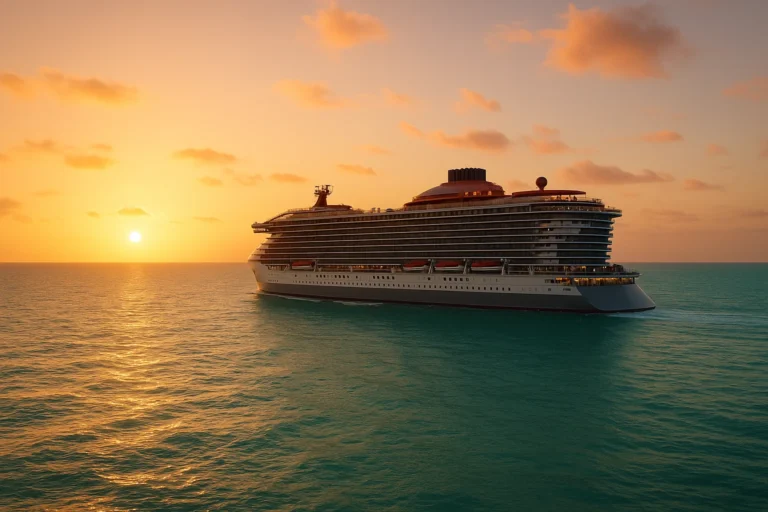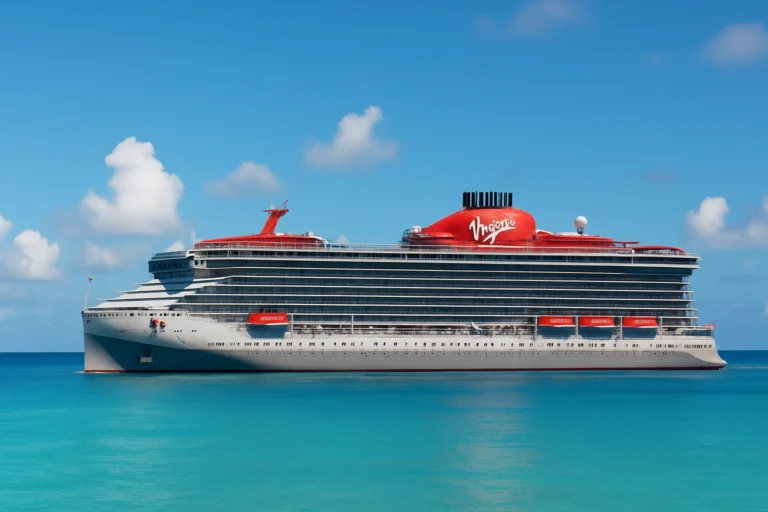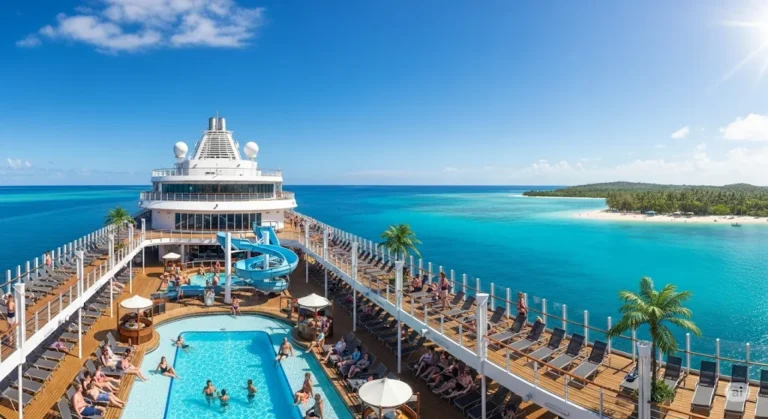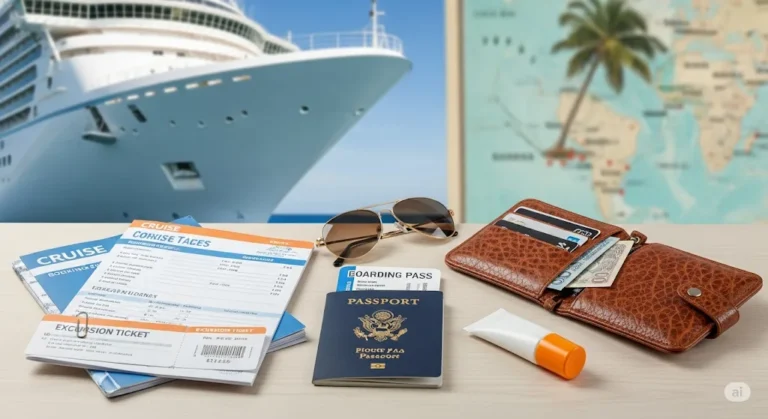How to Choose the Best Cruise Cabin (Avoid Noisy Rooms!)
While the allure of exotic destinations and thrilling onboard activities often takes center stage in cruise planning, the comfort and tranquility of your cabin are paramount for a truly relaxing escape. But with so many options – from cozy interior rooms to sprawling suites – and a ship full of potential noise sources, how do you choose wisely? This ultimate guide will navigate you through the ins and outs of cruise cabin selection, helping you understand where to find your perfect sanctuary and, crucially, how to avoid those dreaded noisy rooms! 🚢🔇 Let’s dive in and unlock the secrets to a peaceful voyage.
1. Understanding Cabin Types: From Cozy Retreats to Lavish Sanctuaries 🌟
Your cabin is your private haven at sea, and selecting the right type sets the tone for your entire cruise. Each comes with its own set of advantages and disadvantages, catering to different budgets and preferences.
1.1. Interior Cabins: The Budget-Friendly Bunker 🛌
These cabins are located on the inside of the ship, meaning they have no windows or balconies. They are typically the most affordable option, making them incredibly popular for budget-conscious travelers or those who plan to spend most of their time exploring the ship or onshore.
- Pros:
- Cost-Effective: By far the cheapest option, allowing you to save money for excursions, specialty dining, or future cruises. 💰
- Ultimate Darkness for Sleep: Without any natural light, interior cabins can be pitch black, making them ideal for those who cherish undisturbed sleep, especially after a long day of sightseeing or late-night entertainment. 😴
- Often Quieter (if well-placed): Paradoxically, interior cabins can sometimes be quieter than exterior ones, as they are insulated from outside elements like wind, waves, or port noise. If positioned strategically (not under a public deck), they can be surprisingly peaceful. 🤫
- Less Motion Sickness (sometimes): Being closer to the center of the ship and on lower decks can sometimes reduce the sensation of motion for those prone to seasickness, and many interior cabins fit this bill. 🤢
- Cons:
- No Natural Light or View: This is the most significant drawback. You lose the connection to the outside world, making it harder to tell if it’s day or night without checking the clock. 🕰️
- Feeling of Confinement: Some travelers might feel claustrophobic or find the lack of a view disconcerting over a long cruise.
- Reliance on Ship’s Lighting: You are entirely dependent on the cabin’s artificial lighting.
Ideal Traveler Profile: Perfect for those on a tight budget, adventurers who plan to be out of their cabin almost constantly, night owls who sleep in, or light sleepers who need complete darkness.
1.2. Oceanview Cabins: A Glimpse of the Horizon 🌊
Also known as “outside” cabins, these rooms feature a window or a porthole (a smaller, circular window) that offers natural light and a view of the ocean or river. However, unlike balcony cabins, the window does not open.
- Pros:
- Natural Light: Provides a sense of time and space, making the cabin feel less enclosed than an interior room. ☀️
- Scenic Views: You can enjoy watching the waves, passing landscapes, or port activities from the comfort of your room. 🏞️
- More Spacious (Often): Many oceanview cabins are slightly larger than interior ones, offering a bit more living space.
- Cons:
- Window Does Not Open: You can’t get fresh air directly into your cabin, and any ocean breeze or sounds remain outside.
- Potentially Obstructed Views: Be wary of cabins labeled “obstructed view,” where a lifeboat, tender boat, or part of the ship’s structure might block your sightline. Always check the deck plan! 🚣♀️
- Potential for Wave Noise: Depending on your deck and the sea conditions, you might hear the sound of waves hitting the hull, which some find soothing, others find disruptive.
Ideal Traveler Profile: Good for those who want natural light and a view but don’t want to splurge on a balcony, or for those who still plan to spend a fair amount of time outside their cabin but appreciate the connection to the outside.
1.3. Balcony Cabins: Your Private Slice of the Ocean 🥂
These are among the most popular cabin types, offering a private outdoor veranda where you can sit, relax, and enjoy the fresh air and uninterrupted views.
- Pros:
- Private Outdoor Space: Your own personal balcony is a game-changer. It’s perfect for enjoying morning coffee, a sunset drink, or simply watching the world go by in privacy. 🌅
- Fresh Air: The ability to open a door and step outside for fresh air is a significant advantage, especially if you get a little stuffy indoors. 🌬️
- Panoramic Views: Unobstructed and ever-changing views, whether it’s the open ocean, a picturesque riverbank, or a bustling port.
- Flexibility: You can enjoy the views and fresh air without having to go up to a public deck.
- Cons:
- Higher Cost: Balcony cabins are significantly more expensive than interior or oceanview cabins. 💸
- Privacy Concerns: Depending on the ship’s design, some balconies might not be entirely private and could be overlooked by neighboring cabins or public decks.
- Potential for Noise from Above/Below: This is a crucial point for this article. Balcony cabins located directly under or above public decks (like pools, bars, lidos) can suffer from noise intrusion (footsteps, chair scraping, music). 🚧
- Weather Dependent: Your balcony’s usability depends entirely on the weather. Cold, rainy, or extremely windy conditions can make it unusable. 🌧️
Ideal Traveler Profile: Perfect for couples, those who enjoy quiet moments with a view, travelers who appreciate fresh air, or those who want a romantic or luxurious touch to their cruise.
1.4. Suites: The Pinnacle of Cruise Luxury ✨
Suites are the largest and most luxurious cabins on a cruise ship, offering enhanced space, elevated amenities, and often exclusive perks.
- Pros:
- Spaciousness: Significantly larger than other cabin types, often featuring separate living areas, multiple bathrooms, or larger balconies. 🛋️
- Elevated Amenities: May include whirlpool tubs, wet bars, multiple TVs, and higher-quality furnishings.
- Exclusive Perks: Often come with concierge services, priority boarding and disembarkation, exclusive lounge access, complimentary specialty dining, and other VIP treatments. 🥂
- Privacy and Comfort: Designed for ultimate relaxation and privacy.
- Cons:
- Significantly Higher Cost: Suites are the most expensive option on the ship. 💎
- Still Susceptible to Location-Based Noise: While generally well-appointed, even a suite can be noisy if it’s unfortunately positioned above or below a major public area. It’s vital to check the deck plan, even for a suite!
Ideal Traveler Profile: For those celebrating a special occasion, luxury travelers, families needing more space, or anyone prioritizing ultimate comfort and exclusive services.
2. The Golden Rule of Cabin Location: Avoiding the Noise Traps 🤫
Once you’ve decided on your preferred cabin type, its location on the ship becomes the single most critical factor in ensuring a peaceful voyage. A poorly chosen location can turn your dream vacation into a sleepless nightmare. The key is to think about what is above, below, and adjacent to your cabin.
📂 Explore More in These Categories
2.1. The “Cabin Sandwich” Strategy: Your Best Bet for Quiet 🥪
This is the ultimate golden rule for choosing a quiet cabin. The “cabin sandwich” strategy involves selecting a cabin that has another cabin directly above it and another cabin directly below it.
- How it Works: When your cabin is “sandwiched” between two other cabins, you benefit from the sound insulation provided by the occupants’ furniture, carpets, and quiet activities. Cabins, by their nature, are designed for sleeping and quiet relaxation, minimizing noise transfer between them.
- Why it’s Effective: This configuration provides the best defense against noise emanating from bustling public areas. If you’re under a pool deck, you’ll hear chairs scraping, footsteps, and early morning setup. If you’re above a nightclub, you’ll feel the bass. But if you’re between two cabins, the chances of significant noise are dramatically reduced.
- How to Identify on a Deck Plan: When viewing the ship’s deck plan, look for areas where a continuous block of cabin symbols exists both directly above and directly below your chosen deck. Avoid sections where your deck is adjacent to (or overlaps with) decks marked as “Lido Deck,” “Pool Deck,” “Promenade Deck,” “Casino,” “Theater,” “Restaurant,” “Galley,” or “Nightclub.”
2.2. Steering Clear of Public Deck Disturbances 🔊
Public areas, by their very nature, are designed for activity and can be major sources of noise.
- Above or Below Nightlife Zones (Theaters, Casinos, Clubs, Bars):
- The Problem: These venues typically host loud music, performances, and late-night revelry. Bass frequencies travel easily through structures, meaning even if the sound isn’t deafening, the constant thrum or vibration can be incredibly disruptive, especially when you’re trying to sleep.
- What to Avoid: Cabins directly above or below the ship’s main theater, casino, disco, dance clubs, or any major bar areas.
- Check the Schedule: Remember that these venues operate late into the night.
- Adjacent to Restaurants & Galleys:
- The Problem: While dining rooms are quiet during meals, the real noise often comes from the galleys (kitchens). Think clanging pots and pans, dishwashers, carts being moved, and crew chatter, which can start very early in the morning (4-5 AM) for breakfast service and continue late into the evening.
- What to Avoid: Cabins that share a wall with, or are directly above/below, a galley or a bustling restaurant, especially those serving breakfast or operating late.
- Near Pools & Lidos:
- The Problem: Pool decks are lively places. Expect noise from footsteps, chairs being dragged, children playing, music from speakers, and early morning setup by crew members preparing for the day (scrubbing, setting out towels, moving loungers).
- What to Avoid: Cabins on decks directly below the main pool areas. Even cabins with balconies directly overlooking a pool deck can be noisy.
- Gyms & Spas:
- The Problem: While seemingly quiet, gyms can generate noise from dropped weights, the thud of treadmills, and exercise classes with music. Spa areas might have noise from water features or treatment rooms.
- What to Avoid: Cabins directly below or adjacent to the gym area.
- Kids’ Clubs:
- The Problem: Children are active and vocal! Laughter, shouting, games, and organized activities can create a constant buzz during the day.
- What to Avoid: Cabins adjacent to or below dedicated kids’ clubs or youth activity centers.
2.3. Navigating Service Area Noise ⚙️
Not all noise comes from passengers having fun. The ship is a working vessel with service areas that can generate unexpected sounds.
- Elevators & Stairwells:
- The Problem: Constant traffic, the “ding” of the elevator arriving, conversations from passengers waiting or walking by can be audible, especially at night when the ship is otherwise quiet.
- What to Avoid: Cabins directly next to the elevator banks or main stairwells. Aim for a cabin a few doors away.
- Laundry Rooms & Crew Areas:
- The Problem: Industrial washing machines, dryers, and general crew activities can generate persistent hums, vibrations, and footsteps.
- What to Avoid: Cabins adjacent to or above/below designated laundry facilities or crew workspaces. These are usually marked on deck plans or can be inferred by gaps in cabin numbering.
- Anchor Drop Zone (Forward):
- The Problem: Cabins located in the very front (bow) of the ship can experience extremely loud and jarring noises when the anchor is dropped or raised during port arrivals and departures, often in the early morning hours. ⚓
- What to Avoid: Cabins on the lowest decks at the very forward end of the ship, especially if your itinerary involves many port calls.
- Engine & Thruster Noise (Aft/Lower Decks):
- The Problem: Cabins in the stern (aft) of the ship, particularly on lower decks, can be affected by the constant hum and vibration of the ship’s engines. Bow thrusters (used for maneuvering in port) can also generate significant noise and vibration in forward cabins.
- What to Avoid: Cabins located directly over or very close to the engine room or thruster areas. While a constant hum might be tolerable for some, the vibrations can be very disruptive.
- Tender/Lifeboat Launch Areas:
- The Problem: If your cabin is on a deck where lifeboats or tender boats are launched (especially for port calls requiring tenders), you might experience noise from the mechanical operations early in the morning.
- What to Avoid: Cabins located directly above or very close to the davits (the structures that hold/lower the boats).
2.4. Midship vs. Forward vs. Aft: Finding Your Sweet Spot 🧭
Beyond avoiding specific noise sources, the general placement along the length of the ship affects both noise and motion.
- Midship (Middle of the Ship):
- Pros: Generally the most stable part of the ship, experiencing the least amount of motion (pitch and roll). This is crucial for those prone to seasickness. 🌊 It’s also often the most central, offering easier access to amenities. Generally quieter as it’s furthest from the engines (aft) and anchor (forward).
- Cons: Can sometimes be pricier due to demand.
- Forward (Bow – Front of the Ship):
- Pros: Can offer unique, unobstructed views from certain cabins.
- Cons: More susceptible to pitching (up and down motion) in rough seas. As mentioned, prone to anchor and thruster noise during port maneuvers. 🌬️
- Aft (Stern – Back of the Ship):
- Pros: Aft-facing balcony cabins often have some of the most sought-after views, offering panoramic vistas of the ship’s wake. 🤩
- Cons: Most susceptible to vibration and engine noise, especially on lower decks. Can also experience more ruling (side-to-side motion) in rougher seas. May be far from central amenities.
3. Beyond Noise: Other Crucial Factors for Cabin Selection ⚓
While quiet is a top priority, other elements contribute to your overall cabin satisfaction.
3.1. Battling Seasickness: Stability is Key 🤢
For those susceptible to motion sickness, cabin location is paramount.
- Lower and Midship Decks: These areas experience the least amount of motion, as they are closest to the ship’s center of gravity. Think of a seesaw – the ends move a lot, the middle barely moves. The same applies to a ship.
- Avoid: High decks and cabins at the very front or very back of the ship, as these areas will feel the most movement.
- Remedies: Even with a stable cabin, consider bringing motion sickness medication, ginger chews, or acupressure bands if you are highly prone. Fresh air from a balcony can also sometimes help. 💊
3.2. Proximity to Amenities: Convenience vs. Quiet 🚶♀️
Consider what facilities you’ll use most often.
- Strategic Convenience: If you plan to spend a lot of time by the pool, at a specific restaurant, or need easy access to the gangway for excursions, choosing a cabin closer to these areas can save you precious vacation time and steps. 👟
- The Trade-off: However, remember the noise factor. A cabin directly next to a busy elevator bank might be convenient for accessing all decks, but it could also be a constant source of disturbance. Balance your desire for convenience with your need for quiet.
3.3. Understanding Deck Plans: Your Secret Weapon 🗺️
The ship’s deck plan is your ultimate tool for smart cabin selection.
- How to Read Them: Deck plans are essentially blueprints of each deck. They show the layout of cabins, public areas, elevators, stairwells, and service areas.
- What to Look For:
- Symbols and Legends: Familiarize yourself with the symbols for different cabin types, accessible cabins, and service areas (e.g., galleys are often marked with kitchen symbols).
- Public vs. Private: Clearly identify which decks are primarily for cabins and which are dedicated to public spaces.
- Overlapping Areas: Pay close attention to how decks overlap. If a public area on Deck 5 is directly under a cabin on Deck 6, that’s a red flag!
- Stairwells and Elevators: Note their locations relative to potential cabin choices.
- Online Resources: Most cruise lines have detailed deck plans available on their websites. Take your time to study them before booking.
3.4. Budget Realities: Balancing Cost and Comfort 💰
Your budget will naturally guide your choices, but it’s important to understand the value proposition.
- Value vs. Cost: Sometimes, spending a little extra for a well-located cabin (even if it’s the same “type” as a cheaper, noisier one) can dramatically improve your cruise experience. A slightly more expensive cabin that guarantees quiet and comfort is often a better investment than a “deal” that leaves you sleepless. 😴➡️😌
- What’s Included: Consider what’s included in different cabin categories. Suites, for example, often come with a host of complimentary perks that can offset their higher initial cost.
- “Guarantee” Cabins: Proceed with Caution: Some cruise lines offer “guarantee” cabins, where you book a cabin type (e.g., “interior guarantee”) but your specific cabin number is assigned later by the cruise line. While these can offer savings, you have no control over the location, meaning you could end up in a noisy or inconvenient spot. Only opt for a guarantee cabin if you are highly flexible and less sensitive to potential noise or motion. 🤔
3.5. The Power of Reviews: Learning from Others’ Experiences 🗣️
Don’t underestimate the wisdom of the crowd.
- Where to Find Them: Websites like Cruise Critic, TripAdvisor, and various travel forums are goldmines for specific cabin reviews.
- What to Look For:
- Specific Cabin Numbers: Many reviewers will mention the exact cabin number they stayed in and comment on its pros and cons, especially regarding noise.
- Common Themes: Look for recurring complaints about specific areas of the ship or cabin types. If multiple people mention noise from the nightclub on Deck 7, take heed!
- Photos and Videos: Some reviews include photos or even videos, giving you a visual sense of the cabin and its surroundings. 📸
- Filter by Ship: Make sure you’re reading reviews for the specific ship you’ll be sailing on, as cabin layouts and noise issues can vary even within the same cruise line’s fleet.
Conclusion: Your Perfect Cabin Awaits! ✨
Choosing the best cruise cabin is far more than just picking a price point; it’s about curating your ideal vacation environment. While the allure of the itinerary and the ship’s amenities are important, the tranquility and comfort of your private space are paramount for true relaxation. By meticulously consulting the deck plan, prioritizing the “cabin sandwich” strategy, understanding potential noise sources, and factoring in your personal preferences for motion and convenience, you empower yourself to make an informed decision. 🧠✅
A thoughtfully chosen cabin ensures you get the rest you need, providing a peaceful sanctuary from which to embark on your daily adventures and return to recharge. It allows you to fully savor the breathtaking views, the fresh sea air, and the sheer joy of being on holiday, transforming your cruise into an even more memorable and perfectly tailored experience. Happy sailing! 🛳️💖
Frequently Asked Questions (FAQ) About Cruise Cabin Selection 🤔
- Q1: Which deck is best for a quiet cabin?
→ Generally, the middle decks (e.g., decks 7-9 on a 12-deck ship, or comparable middle decks) are considered the quietest. Look for decks that are “sandwiched” between other cabin decks (cabin above, cabin below). This insulates you from noise originating from public areas like pools, restaurants, or entertainment venues, which are usually found on the highest or lowest decks. 🤫 - Q2: How can I tell if a cabin is above/below a noisy area?
→ Always consult the ship’s deck plan before booking. These plans are usually available on the cruise line’s website. Look at what is located directly above and directly below your prospective cabin. Identify areas marked as:- Dining Rooms (especially galleys/kitchens 🍽️)
- Bars, Lounges, Nightclubs, Casinos 🎶
- Theaters or Show Lounges 🎭
- Pool Decks, Lidos, or Sports Courts 🏊♂️
- Gyms or Spas 💪
- Kids’ Clubs or Youth Centers 🧒
- Laundry Rooms or Crew Areas 🧺
- Elevator Banks or Main Stairwells 🚶♀️
If your cabin is under or over any of these, consider choosing a different one.
- Q3: Are interior cabins always the quietest?
→ Not necessarily always, but they can often be very quiet if they are strategically located within a “cabin sandwich” of other interior cabins. Since they lack windows, they are inherently free from exterior noise like wind, waves, or port activity. However, if an interior cabin is located near a noisy public area or service zone (like a galley or laundry), it can still be affected by internal ship noise. The key is location, even for interior rooms. 🔇 - Q4: What if I get seasick easily? Which cabin should I choose?
→ For those prone to motion sickness, the most stable cabins are located midship (in the middle of the ship) and on lower decks. This area experiences the least amount of pitching (up-and-down motion) and rolling (side-to-side motion). Avoid cabins at the very front (bow) or very back (stern) of the ship, and on higher decks, as these areas feel the most movement. 🤢⚓ - Q5: Is it worth paying extra for a balcony cabin?
→ This depends entirely on your preferences and budget. A balcony cabin offers private outdoor space, fresh air, and constantly changing scenic views (like sunsets 🌅 or sailing into port). Many find it significantly enhances their cruise experience, especially for relaxing moments or simply enjoying the ocean/river breeze. If these aspects are important to you and your budget allows, then yes, it can be absolutely worth the extra cost. If you plan to spend very little time in your cabin, it might not be. - Q6: Can I change my cabin if it’s too noisy during the cruise?
→ It’s not guaranteed. The possibility of changing cabins once onboard depends entirely on the ship’s occupancy and the cruise line’s policy. If there are available cabins of the same or higher category, and no one else is booked into them, the Guest Services desk might be able to accommodate your request. However, it’s always best to choose carefully before the cruise to avoid this situation entirely. 🤞 - Q7: What is a “guarantee cabin” and should I book one?
→ A “guarantee cabin” means you book a specific category of cabin (e.g., “interior guarantee” or “balcony guarantee”), but the cruise line assigns your specific cabin number at a later date, usually closer to the sailing.- Pros: They often come with a lower price than booking a specific cabin number. 💸
- Cons: You have no control over the cabin’s exact location. You could end up in a prime spot, or you could be assigned a cabin in a noisy area (e.g., above a nightclub) or with an obstructed view.
- Recommendation: Only book a guarantee cabin if you are very flexible, are not particularly sensitive to noise or motion, and prioritize saving money over precise location control. If a quiet cabin is a must, it’s safer to choose your specific cabin number from the deck plan. 🧐
💬 Share Your Cabin Wisdom! 🗣️
Have you discovered a secret to choosing the perfect, quiet cruise cabin? Do you have a story about a surprisingly noisy room or a wonderfully peaceful one? Or perhaps a clever trick for reading deck plans?
Leave a comment below! Your experience can be incredibly valuable to fellow travelers planning their next unforgettable cruise! Let’s build a community of smart cabin choosers! 👇
📢 Planning your next cruise? Share this comprehensive guide with friends and family!









